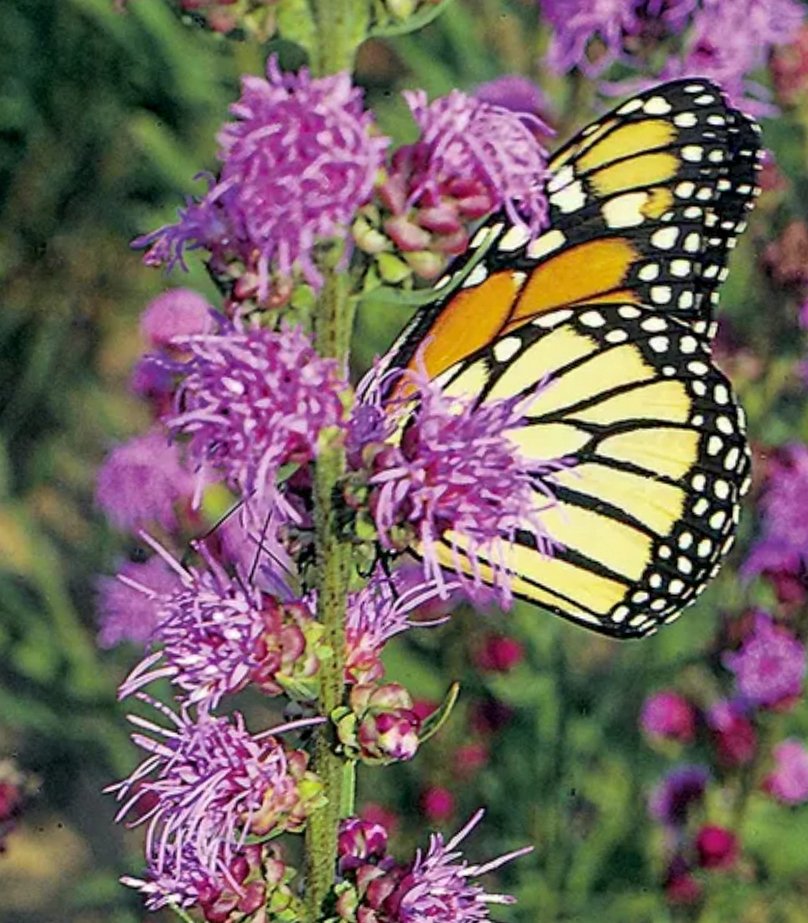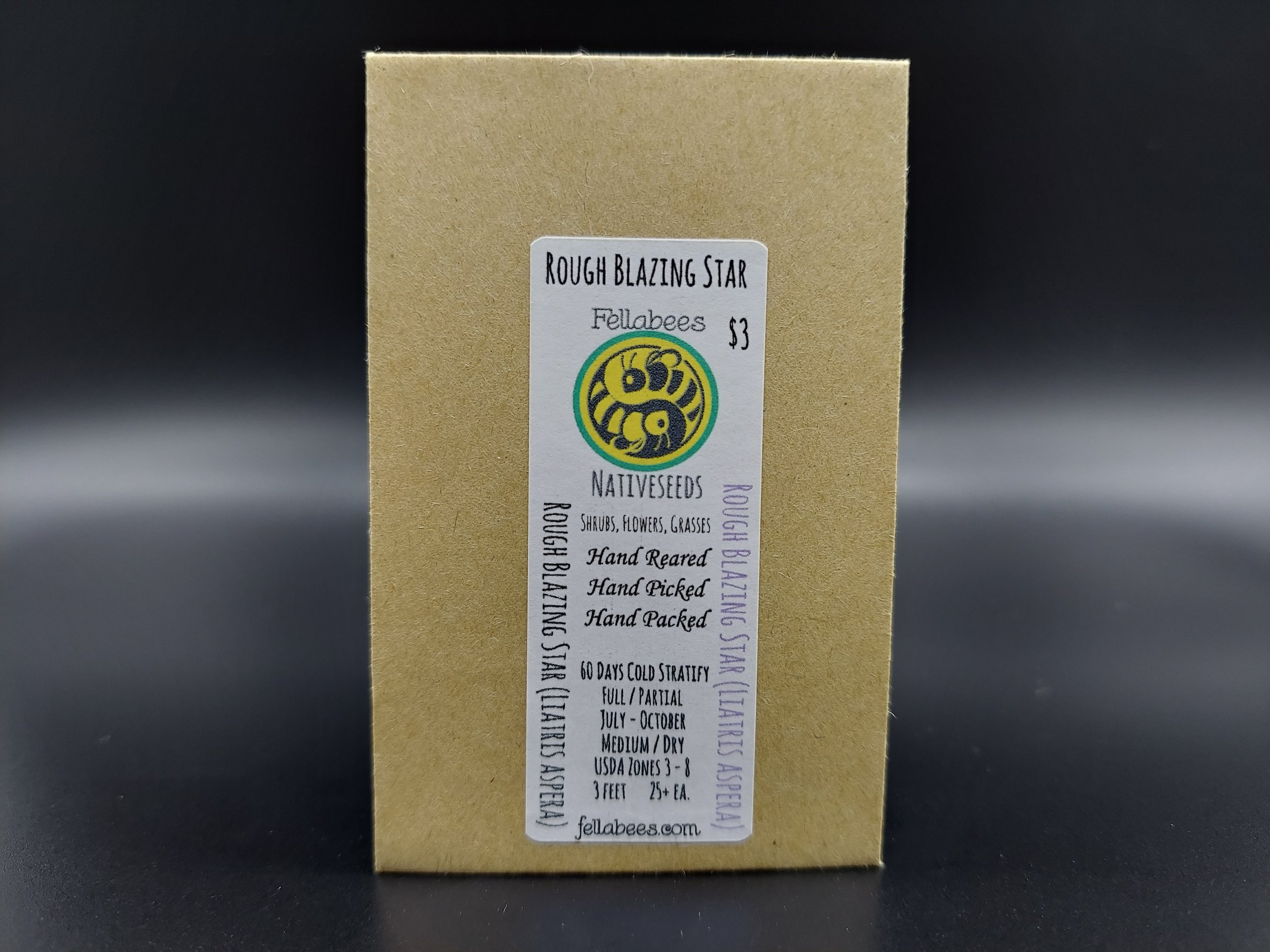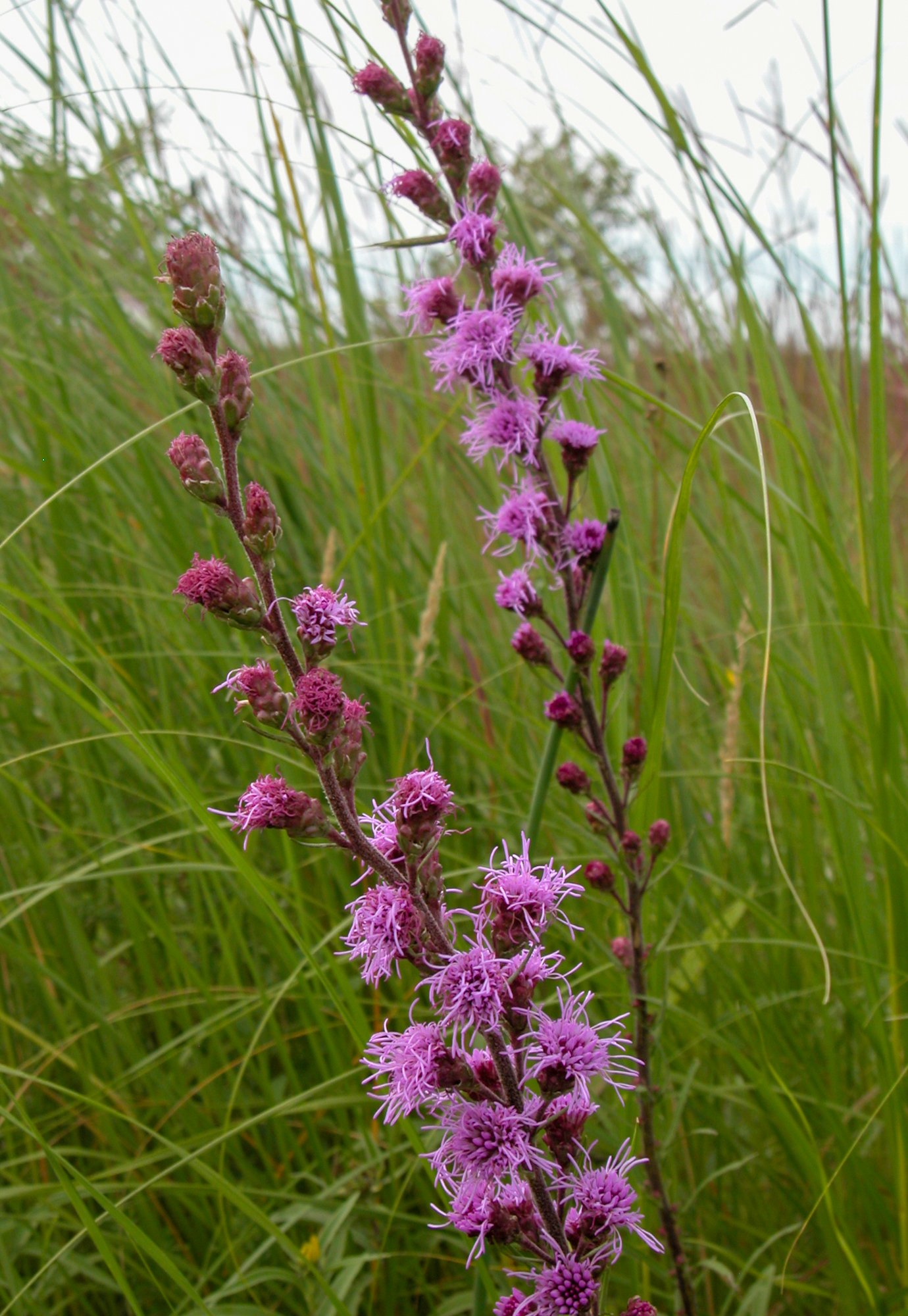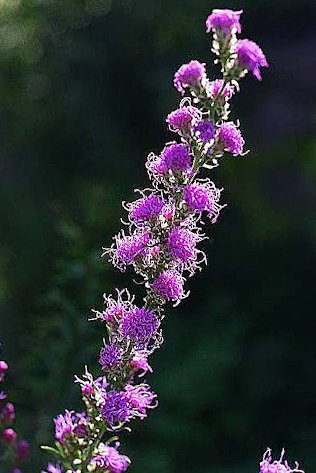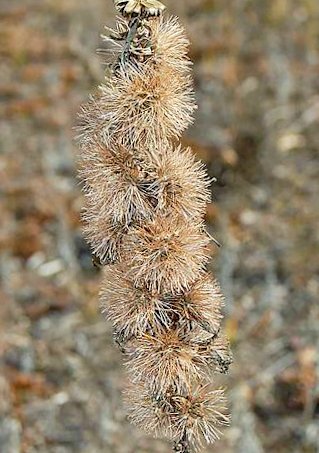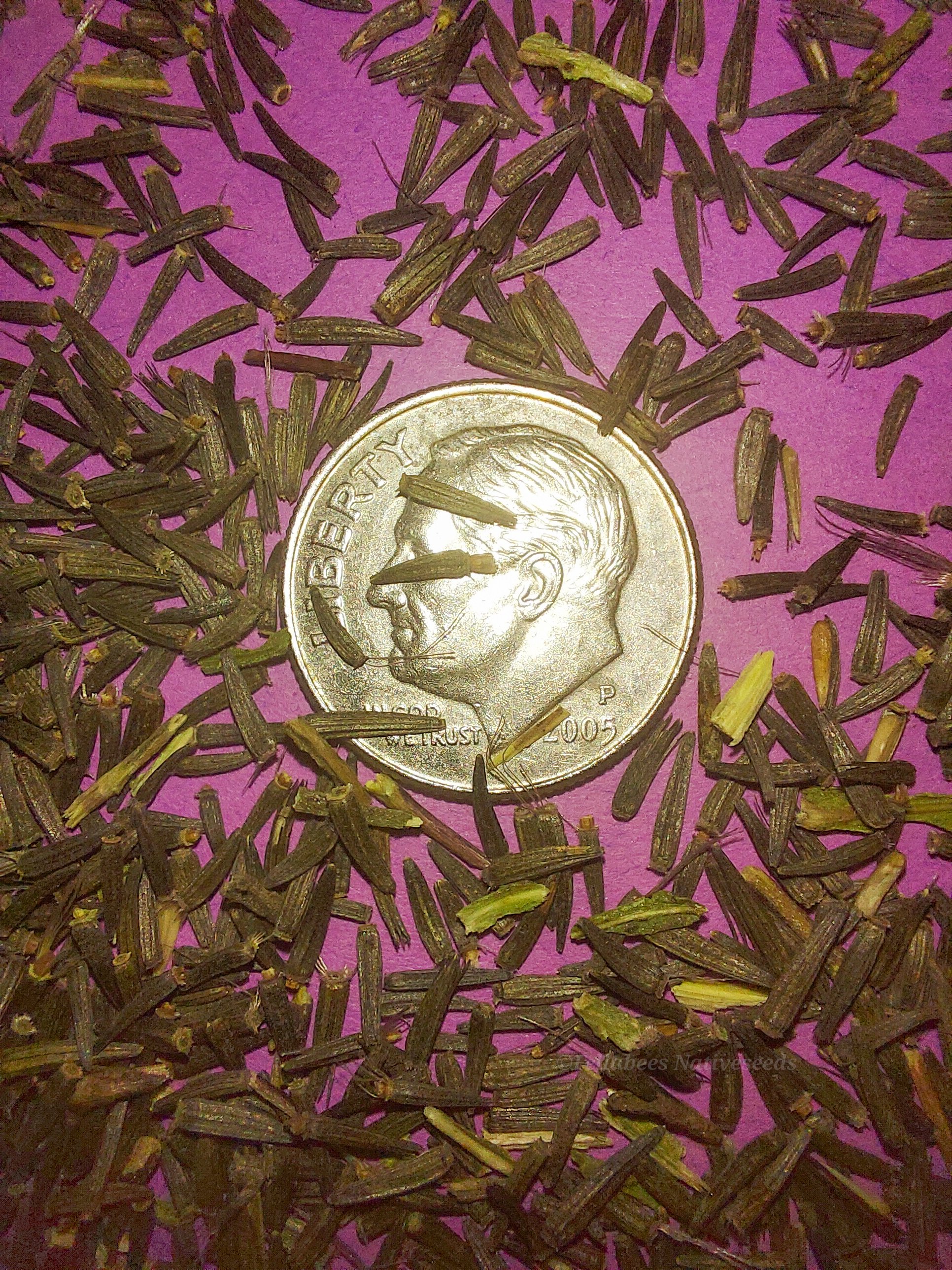Rough Blazing Star (Liatris aspera)
Rough Blazing Star (Liatris aspera)
Liatris aspera is the scientific name for native plant more commonly known as Rough Blazing Star, Button Blazing Star, Lacerate Blazing Star, Tall Prairie Blazing Star, or Tall Gayfeather.
Rough Blazing Star is a perennial wildflower of the diverse and expansive Asteraceae family that is found in Central to Eastern North America in habitats that range from mesic to dry prairie and dry savanna.
Liatris aspera is a perennial herb that grows as a single, erect, unbranched stem between 1 to 6 feet tall. Leaves are numerous on the stem, alternate, and narrowly lanceolate with the lower leaves larger, 15 inches long and 1 inch wide, which gradually become smaller and narrower as they climb higher on the plant.
The inflorescence is an erect raceme with numerous, purple, button-like flower heads, short-stalked or stalkless, blooming from the top down. It flowers from mid-August through October, with plentiful seed becoming ripe in October to November.
This plant is a pollinator powerhouse that brings in the beat of the best of the pollinating classes. From hummingbirds, to butterflies such as Monarchs, Sulfers, Swallowtails, and Painted Ladies, to many native bees, such as bumblebees, carpenter bees, sweat and mining bees, and leaf cutting bees, as well as pollinating predators too!
This plant is native from North Dakota South through Texas, and East all the way to North Carolina where it is listed as present but rare in several counties.
Plant Details
USDA Zones: 3-8
Germination Needs: 60 Days Cold Stratification
Life Cycle: Perennial
Sun Exposure: Full to Partial
Soil Moisture: Medium, Medium-Dry, Dry
Plant Spacing: 1 - 1½ feet
Height: 3 feet
Bloom time: July, August, September, October
Bloom Color: Purple
Advantages :
Pollinator Favorite: butterflies, moths, bees, wasps, beetles
Bird Favorite: seeds, insects, fruit, nectar, nesting, perchs.
Excellent in the home landscape!
Native to, or present in: Wisconsin, Minnesota, Iowa, Illinois, Indiana, Michigan, Ohio, New York, West Virginia, Virginia, Kentucky, Tennessee, North Carolina, South Carolina, Georgia, Florida, Alabama, Mississippi, Louisiana, Texas, Arkansas, Oklahoma, Missouri, Kansas, Nebraska, South Dakota, and North Dakota.
.
.
Packet quantities:
We pride ourselves on ethical, hands on, ecological management, using no mechanical or chemical methods whatsoever.
All of our native seed is hand reared, hand picked, and hand packed from native prairies under our exclusive management, never breaking chain of custody from the field until it is sent to you. Each packet is hand prepared for shipment by us, directly.
Small seed species will contain greater than 20-25 seed
Large seed species will contain greater than 10-15 seed
It is our mission to spread the wealth of native plant and pollinator ecological sustainability, and educate back yard gardeners as well as corporate and government entities in how to germinate, grow, and benefit from native synergies.
Thank you for your support, it is because of you, that we can grow together to do, what we do.🐛🦋🐝🐞🌾🌱🌼🧡
Rough Blazing Star (Liatris aspera)
Liatris aspera is the scientific name for native plant more commonly known as Rough Blazing Star, Button Blazing Star, Lacerate Blazing Star, Tall Prairie Blazing Star, or Tall Gayfeather.
Rough Blazing Star is a perennial wildflower of the diverse and expansive Asteraceae family that is found in Central to Eastern North America in habitats that range from mesic to dry prairie and dry savanna.
Liatris aspera is a perennial herb that grows as a single, erect, unbranched stem between 1 to 6 feet tall. Leaves are numerous on the stem, alternate, and narrowly lanceolate with the lower leaves larger, 15 inches long and 1 inch wide, which gradually become smaller and narrower as they climb higher on the plant.
The inflorescence is an erect raceme with numerous, purple, button-like flower heads, short-stalked or stalkless, blooming from the top down. It flowers from mid-August through October, with plentiful seed becoming ripe in October to November.
This plant is a pollinator powerhouse that brings in the beat of the best of the pollinating classes. From hummingbirds, to butterflies such as Monarchs, Sulfers, Swallowtails, and Painted Ladies, to many native bees, such as bumblebees, carpenter bees, sweat and mining bees, and leaf cutting bees, as well as pollinating predators too!
This plant is native from North Dakota South through Texas, and East all the way to North Carolina where it is listed as present but rare in several counties.
Plant Details
USDA Zones: 3-8
Germination Needs: 60 Days Cold Stratification
Life Cycle: Perennial
Sun Exposure: Full to Partial
Soil Moisture: Medium, Medium-Dry, Dry
Plant Spacing: 1 - 1½ feet
Height: 3 feet
Bloom time: July, August, September, October
Bloom Color: Purple
Advantages :
Pollinator Favorite: butterflies, moths, bees, wasps, beetles
Bird Favorite: seeds, insects, fruit, nectar, nesting, perchs.
Excellent in the home landscape!
Native to, or present in: Wisconsin, Minnesota, Iowa, Illinois, Indiana, Michigan, Ohio, New York, West Virginia, Virginia, Kentucky, Tennessee, North Carolina, South Carolina, Georgia, Florida, Alabama, Mississippi, Louisiana, Texas, Arkansas, Oklahoma, Missouri, Kansas, Nebraska, South Dakota, and North Dakota.
.
.
Packet quantities:
We pride ourselves on ethical, hands on, ecological management, using no mechanical or chemical methods whatsoever.
All of our native seed is hand reared, hand picked, and hand packed from native prairies under our exclusive management, never breaking chain of custody from the field until it is sent to you. Each packet is hand prepared for shipment by us, directly.
Small seed species will contain greater than 20-25 seed
Large seed species will contain greater than 10-15 seed
It is our mission to spread the wealth of native plant and pollinator ecological sustainability, and educate back yard gardeners as well as corporate and government entities in how to germinate, grow, and benefit from native synergies.
Thank you for your support, it is because of you, that we can grow together to do, what we do.🐛🦋🐝🐞🌾🌱🌼🧡
Rough Blazing Star (Liatris aspera)
Liatris aspera is the scientific name for native plant more commonly known as Rough Blazing Star, Button Blazing Star, Lacerate Blazing Star, Tall Prairie Blazing Star, or Tall Gayfeather.
Rough Blazing Star is a perennial wildflower of the diverse and expansive Asteraceae family that is found in Central to Eastern North America in habitats that range from mesic to dry prairie and dry savanna.
Liatris aspera is a perennial herb that grows as a single, erect, unbranched stem between 1 to 6 feet tall. Leaves are numerous on the stem, alternate, and narrowly lanceolate with the lower leaves larger, 15 inches long and 1 inch wide, which gradually become smaller and narrower as they climb higher on the plant.
The inflorescence is an erect raceme with numerous, purple, button-like flower heads, short-stalked or stalkless, blooming from the top down. It flowers from mid-August through October, with plentiful seed becoming ripe in October to November.
This plant is a pollinator powerhouse that brings in the beat of the best of the pollinating classes. From hummingbirds, to butterflies such as Monarchs, Sulfers, Swallowtails, and Painted Ladies, to many native bees, such as bumblebees, carpenter bees, sweat and mining bees, and leaf cutting bees, as well as pollinating predators too!
This plant is native from North Dakota South through Texas, and East all the way to North Carolina where it is listed as present but rare in several counties.
Plant Details
USDA Zones: 3-8
Germination Needs: 60 Days Cold Stratification
Life Cycle: Perennial
Sun Exposure: Full to Partial
Soil Moisture: Medium, Medium-Dry, Dry
Plant Spacing: 1 - 1½ feet
Height: 3 feet
Bloom time: July, August, September, October
Bloom Color: Purple
Advantages :
Pollinator Favorite: butterflies, moths, bees, wasps, beetles
Bird Favorite: seeds, insects, fruit, nectar, nesting, perchs.
Excellent in the home landscape!
Native to, or present in: Wisconsin, Minnesota, Iowa, Illinois, Indiana, Michigan, Ohio, New York, West Virginia, Virginia, Kentucky, Tennessee, North Carolina, South Carolina, Georgia, Florida, Alabama, Mississippi, Louisiana, Texas, Arkansas, Oklahoma, Missouri, Kansas, Nebraska, South Dakota, and North Dakota.
.
.
Packet quantities:
We pride ourselves on ethical, hands on, ecological management, using no mechanical or chemical methods whatsoever.
All of our native seed is hand reared, hand picked, and hand packed from native prairies under our exclusive management, never breaking chain of custody from the field until it is sent to you. Each packet is hand prepared for shipment by us, directly.
Small seed species will contain greater than 20-25 seed
Large seed species will contain greater than 10-15 seed
It is our mission to spread the wealth of native plant and pollinator ecological sustainability, and educate back yard gardeners as well as corporate and government entities in how to germinate, grow, and benefit from native synergies.
Thank you for your support, it is because of you, that we can grow together to do, what we do.🐛🦋🐝🐞🌾🌱🌼🧡

